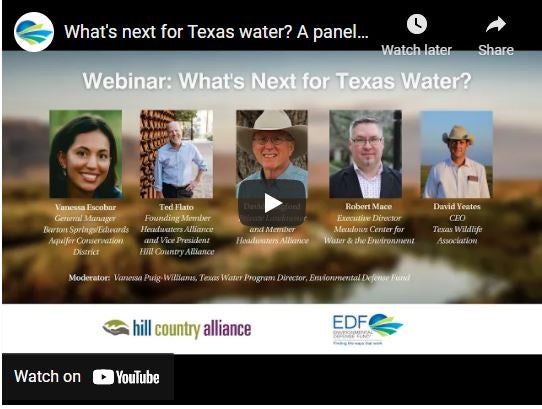Last weekend I paddled on the Blanco River with my family. We swam in spring-fed swimming holes, fly fished and lounged in shallow sections of the river, which was flowing nicely thanks to recent rains that ended drought conditions across Texas.
But it’s hard to ignore that Texas is sitting in the shadow of one of the worst droughts in history — one that’s crippling the rest of the West.
As temperatures rise and groundwater levels remain low with little rain in the forecast, it is imperative that we develop solutions to manage our water supplies more sustainably.
Unfortunately, state leaders put water on the back burner this legislative session, failing to take action on several water bills — even a benign bill to study groundwater and surface water interactions. But just because state leaders haven’t taken action doesn’t mean we can’t.
Here are three steps that all Texans can take now to build momentum behind protecting our rivers, streams and groundwater.

EDF partnered with the Hill Country Alliance and the Headwaters Alliance to convene a panel to assess “What’s Next for Texas Water?” in light of inaction by state policymakers.
1. Mobilize around common-sense solutions.
For starters, we can look at the difficulties that water advocates faced this past legislative session as an opportunity to build a bigger groundswell of support to protect Texas rivers.
David Yeates, CEO of the Texas Wildlife Association, has called for bringing together stakeholders in an inclusive, open, honest and organized way to reach consensus on much-needed water solutions — potentially around increasing funding and improving the science of groundwater.
2. Educate and engage the public.
“The lack of understanding of natural resources is absolutely astonishing in today’s public, and we’ve got to do something about that,” said David Langford, a founding member of the Headwaters Alliance. “Once the public becomes aware of what the issue is and understands it, their elected officials are going to follow what they’re elected to do.”
To help raise public awareness of water issues in the state, Langford wrote an op-ed in the Dallas Morning News in support of a bill that would require the state to study the connections between groundwater and surface water.
3. Close science gaps.
Robert Mace, executive director at the Meadows Center for Water and the Environment at Texas State University, noted one challenge is that groundwater systems are much more difficult to measure and monitor than rivers. As a result, many groundwater districts lack the data they need to set policies and achieve management goals.
One exception that could prove to be a model for other districts is the Barton Springs/Edwards Aquifer Conservation District. Vanessa Escobar, the district’s general manager, noted that one major element of her district’s management approach is investing in science to build equitable policies. Another element is a regulatory framework that can adapt as science and conditions evolve, which will be essential with climate change and population growth.
“The next bad drought really concerns us groundwater district managers,” Escobar has admitted.
The next bad drought also concerns me and should concern state legislators, too.
My hope is that Texans can rally to support strong science and build more support for sustainable water management so that state leaders will finally take action. Let’s get to work.
The next bad drought concerns me and should concern state legislators, too. Share on X








